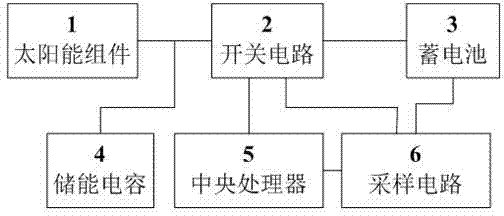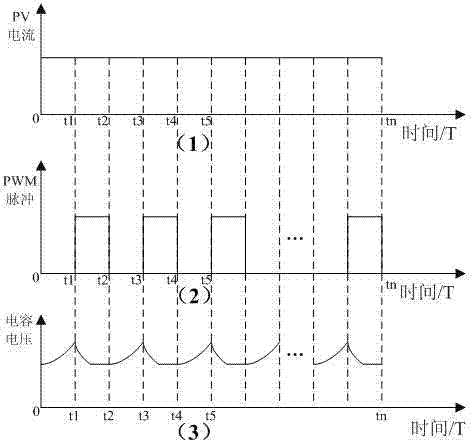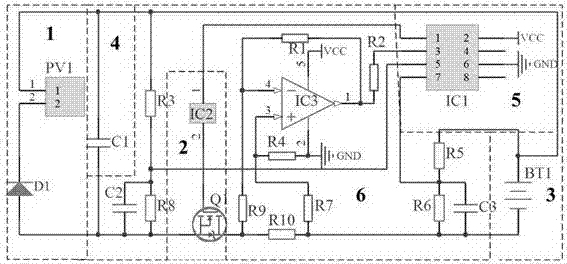Full-range pulse-width modulation charging technology for photovoltaic power generation
A technology of pulse width modulation and photovoltaic power generation, which is applied to battery circuit devices, current collectors, electric vehicles, etc., can solve problems such as rising system costs, battery outgassing, and empty batteries, so as to reduce maintenance costs and overall costs , the effect of reducing the degree of vulcanization
- Summary
- Abstract
- Description
- Claims
- Application Information
AI Technical Summary
Problems solved by technology
Method used
Image
Examples
Embodiment 1
[0016] Embodiment 1: as image 3 The one shown uses an energy storage capacitor as an intermediate energy storage device. The connection mode between the various electronic components is that the positive pole of the solar module PV1 is connected to the positive pole of the capacitor C1, the negative pole of the solar module PV1 is connected to the positive pole of the diode D1, and the diode The negative pole of D1 is connected to the negative poles of capacitors C1 and C2, the resistor R8 is connected in parallel with capacitor C2, the other end of resistor R8 is connected to one end of resistor R3, and the other end of R3 is connected to the positive pole of solar module PV1. The source of the field effect transistor Q1 is connected to the cathode of the diode D1, the gate of the field effect transistor Q1 is connected to the second pin of the driver chip IC2, the drain resistor R9 of the field effect transistor Q1 and one end of the resistor R10, the resistor R10 The other...
Embodiment 2
[0017] Embodiment 2: as Figure 4 The one shown uses energy storage capacitors as intermediate energy storage devices. In some ordinary low-power controllers, in order to reduce costs and increase product price competitiveness, the design of some data acquisition and control circuits can be appropriately simplified. The connection method is as follows: the positive pole of the solar photovoltaic module PV1 is connected to the positive pole of the energy storage capacitor C1, the negative pole of the solar photovoltaic module PV1 is connected to the positive pole of the diode D1, the negative pole of the diode D1 is connected to the negative pole of the energy storage capacitor C1, the capacitor C2 and the resistor R3 One end of the parallel connection is connected to the negative pole of the energy storage capacitor, the other end is connected to the first pin of the central processing unit IC2, one end of the resistor R1 is connected to the positive pole of the solar photovolt...
PUM
 Login to View More
Login to View More Abstract
Description
Claims
Application Information
 Login to View More
Login to View More - R&D
- Intellectual Property
- Life Sciences
- Materials
- Tech Scout
- Unparalleled Data Quality
- Higher Quality Content
- 60% Fewer Hallucinations
Browse by: Latest US Patents, China's latest patents, Technical Efficacy Thesaurus, Application Domain, Technology Topic, Popular Technical Reports.
© 2025 PatSnap. All rights reserved.Legal|Privacy policy|Modern Slavery Act Transparency Statement|Sitemap|About US| Contact US: help@patsnap.com



